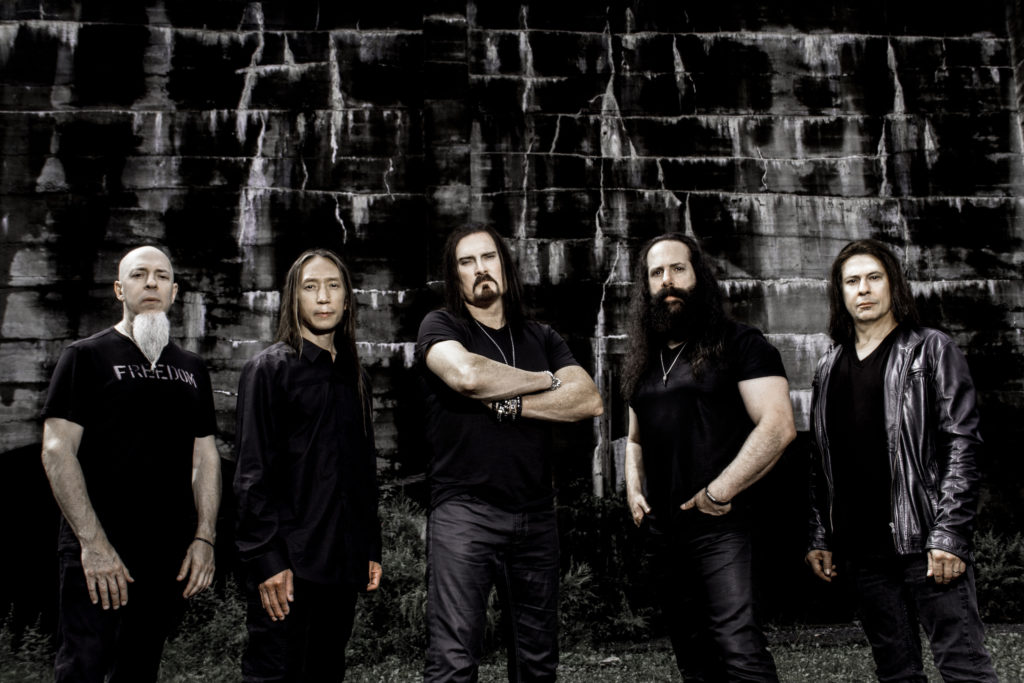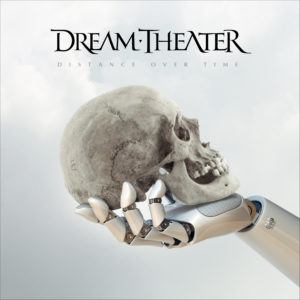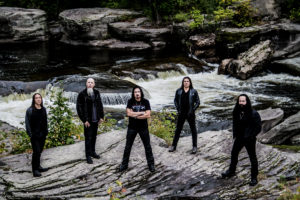
After more than 30 years, 14 albums and countless tour stops around the world, one of progressive metal’s most acclaimed and successful pioneering bands chose a powerful, but rather old-school approach to creating their latest album.
The members of Dream Theater chose to hunker down together last summer at a residential studio, located in a rural part of New York State, spending time feasting together, chatting, exploring the outdoors, reinvigorating their bond as bandmates and friends. Amidst the banter and laughter, beer and bourbon, a slate of 10 tracks (including a bonus song, Viper King) was composed and recorded, leading to the Feb. 22 release of the remarkable Distance Over Time through InsideOut Music.
Produced by band co-founder and guitarist John Petrucci, the album is infused with a frisson of passionate energy and the elevated musicianship and compositional intricacy that fans of the band have been used to over their 13 previous studio albums. But there is something more, an almost indescribable vibe that was captured through what was a new methodology for the veteran band, which, besides Petrucci is composed of Canadian vocalist James LaBrie, keyboardist Jordan Rudess, bassist John Myung, and drummer Mike Mangini, the relative newcomer in the quintet, who came along eight years ago replacing long-time skin basher Mike Portnoy.
“It sounded like the best thing to do, to sort of spend time more socially as a band and write music in between as we barbecued and hung out, without any distractions. It’s something that we had never done, and the timing felt right. It was this great idea that we were in a remote area that was private and there were no outside distractions. We were able to have a really immersive experience as a band. It really made for a great record, I think,” said Petrucci from his home on Long Island.
“Believe it or not, even though bands like ours spend a lot of time together in between being in the studio and touring, you don’t really spend a lot of social time together. Even on the road, everybody goes to a separate hotel room and you’re not really living together necessarily. So, this evolved where we’re all in the same place, on the same schedule, and we’re deciding who is going to cook that night and what we’re going to eat, and then sharing a glass of bourbon or wine at the end of the night, because no one has to drive. Just having that kind of a social setting is not something bands normally do as much as you think they would. We all love each other, we’re all brothers so it was a great opportunity to drink in that bond and do that. So, it was really cool.”
Petrucci said the atmosphere thus created at the Yonderbarn facility in Monticello, New York, was conducive to an even more connective and collaborative approach to creating music than normal, resulting in an album that has a focus and cohesive, unified feel, more so than perhaps any of the band’s previous albums.
“It was a lot more collective as there was more input from everybody. Even Mike Mangini, who has been in the band for eight years now, it’s the first time he wrote lyrics and the first time he really contributed musically significantly, which was great. There is a more collective sound, and I think because of the way we did it and where we did it, there is a more sort of organic and primal feel to the music and to the sound of the record,” he explained.
 “The barn that we were in just had a great room that sounded amazing and we made sure to capture that. Also, being together and having all our gear set up with the guitars cranking in the room and sound bouncing off the wood walls, backed up by the thundering drums made for a more energetic, riff-driven, groove intensive sound. And also, it just sounds very live; it sounds like what the band sounds like when we play live. Everything from the environment to the setting to the way that it was recorded all had an impact on how the music came out, for sure.”
“The barn that we were in just had a great room that sounded amazing and we made sure to capture that. Also, being together and having all our gear set up with the guitars cranking in the room and sound bouncing off the wood walls, backed up by the thundering drums made for a more energetic, riff-driven, groove intensive sound. And also, it just sounds very live; it sounds like what the band sounds like when we play live. Everything from the environment to the setting to the way that it was recorded all had an impact on how the music came out, for sure.”
Generally speaking, each Dream Theater album has some sort of overarching message, and in a number of cases, including the band’s last album, 2016’s The Astonishing, it’s an outright concept album. Petrucci said in the case of Distance Over Time, the way the album was made, the way the band reinforced its bond as friends, not just musicians, the way that the process unfolded within this spirit of brotherhood is actually the message he hopes is imparted to keen listeners.
“When you listen to a Dream Theater record from start to finish, it has a curve, it has an arc, it has a story to tell, even if it’s not a concept: there’s a musical story going on and everything is purposeful. From the song that starts the record to the song that ends it, it’s not just an arbitrary collection of songs that are meant to be consumed as individual meals. It’s meant to be listened to as an entire record, the same way we did when we put on a Rush album and turned off the lights and listened to the whole thing, or a Pink Floyd record or Yes record. We are still in that headspace, and I don’t think that’s ever going to change, even if the music industry changes around us. I think our motivation is always going to come from that place,” he said.
“For this record, the story is really about how the record was made. There’s not a lyrical story, there’s not really a musical theme running throughout, its more like I think the environment where we did it, how we did it, is the biggest part of it. That’s the story, that is the thing that gives the album it’s personality.
“What I would want people to get from it is to understand what happens when a band hangs out together, barbecues, eats some burgers, drinks some bourbon and writes some music in between in a barn, in a place where they’re all together and they can look outside and see bears and deer and badgers – what would that sound like? This album is what it sounds like. If you were a fly on the wall an could have been there, this is where we’re at in our lives right now. I think that’s the big story on this record.”
One of the stand-out tracks is Untethered Angel, which was composed primarily by Petrucci himself, and is his way of empathizing with the difficulties facing young people in an increasingly harsh and insensitive world.
“I am kind of reflecting on today’s young people and how, especially for ones who are in creative fields and just starting out, everything is very scary out there because of social media, because of all the criticism and judgement. Everybody is an expert, everybody believes they can do it better, everybody is a critic. And it’s sort of about this fear of ‘how am I going to do this.’ And it’s a generational thing because I remember we didn’t feel that way when we were a young band starting out. For us, anything was possible. If Iron Maiden could do it, we could do it. We had tunnel vision and ignored the naysayers. Now there seems to be this paralyzing fear that grips young creative people and I see it all too often. It’s become sort of an epidemic,” he explained, adding that the song Paralyzed, which is mostly his lyrical composition as well, again looks at young people, but more from the perspective of his own youth.
“It’s like I am almost looking back at the younger me and thinking about the way that I behaved and acted sometimes in my relationships with my parents, my friends, with other people, and how I would put these roadblocks in place that would paralyze the situation, because I was digging my heels in or being obstinate, and how that really didn’t help things. It’s a chance for me to try and tell my younger self, ‘hey, stop doing that, it’s not going to get you anywhere.”
 The powerfully compelling track Pale Blue Dot is based on the famous 1994 Carl Sagan speech and later book, that offers a hopeful conclusion to the album, in the sense that it asks the listener to look at the world from a different perspective to see both its fragility, but also its beauty and intrinsic strength.
The powerfully compelling track Pale Blue Dot is based on the famous 1994 Carl Sagan speech and later book, that offers a hopeful conclusion to the album, in the sense that it asks the listener to look at the world from a different perspective to see both its fragility, but also its beauty and intrinsic strength.
“It’s one of my favourites on the album. I am a big Carl Sagan fan and it stems from a speech he wrote about the Voyager probe’s mission photographs of the Earth from the edge of the solar system back in the late 1980s. it’s just a really poignant and really profound message, and I love his reflection of that moment, and we wanted to really try and capture that as a way to end the record.”
Although Dream Theater has sold more than 15 million albums, they truly made their reputation through relentless touring, and continue to see themselves as primarily a working band. For 2019, to support Distance Over Time, an ambitious itinerary is already in the offing for Dream Theater, with an early spring run in North America starting in San Diego on March 20, with a show in Toronto at the Sony Centre for the Performing Arts on April 4, at the Place Des Arts in Montreal the following evening, and in Quebec City at Theatre Capitole on April 6. In June the band heads to Europe for the summer festival circuit and before the year is out, they will have toured through Europe, South America, Asia, Australia and North America for a second time.
For tour dates and more information, visit http://dreamtheater.net.
- Jim Barber is a veteran award-winning journalist and author based in Napanee, ON, who has been writing about music and musicians for a quarter of a century. Besides his journalistic endeavours, he now works as a communications and marketing specialist. Contact him at jimbarberwritingservices@gmail.com.
https://www.youtube.com/watch?v=C7m7l8iqGAk
SHARE THIS POST:
